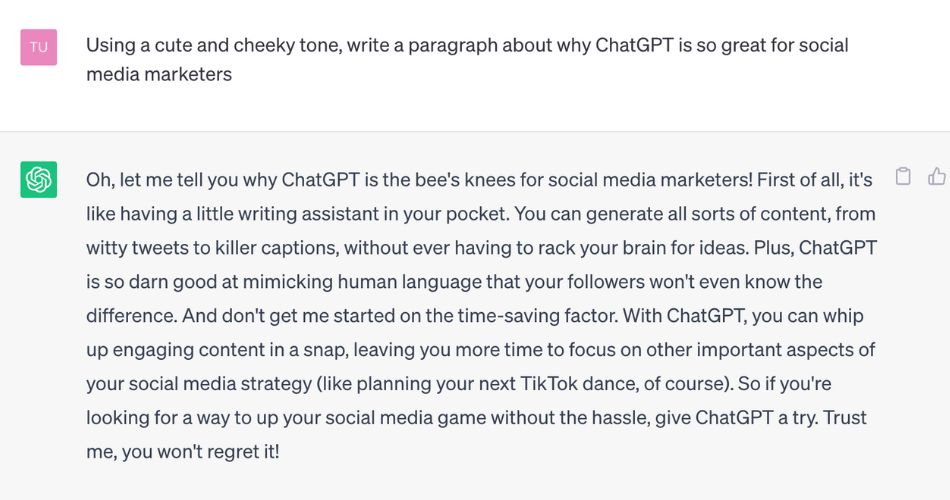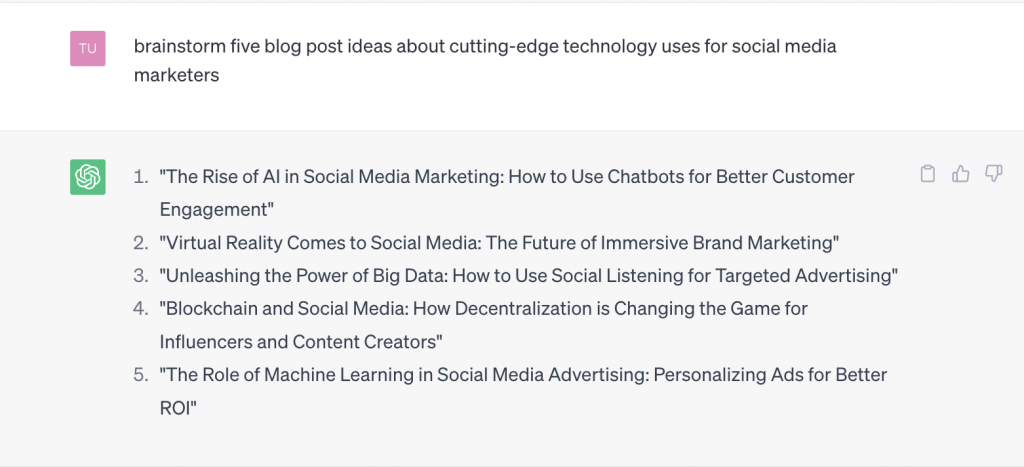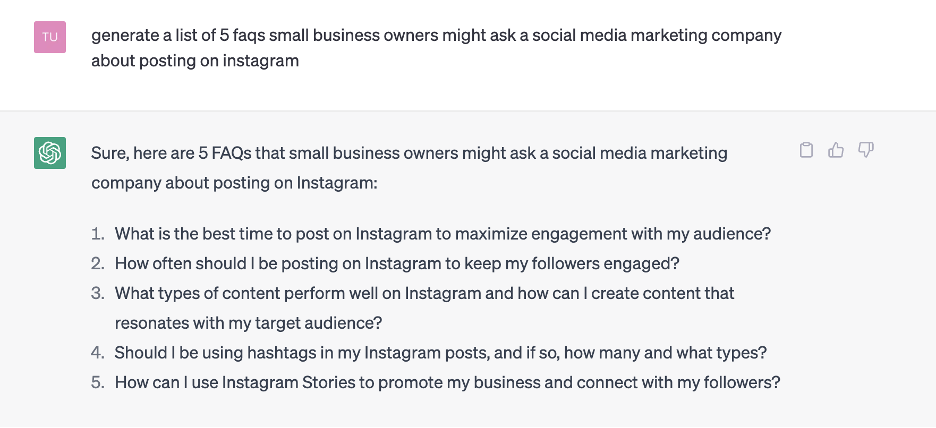ChatGPT is being heralded as a game-changer for social media management. And it’s easy to see why. What business owner wouldn’t want to “outsource” an AI-integrated (Artificially Intelligent) tool? The bots brainstorm content, automate scheduling, and even write entire blog posts (almost).
But do AI-based tools live up to the hype?
In this (human-generated, AI-assisted) article, we’ll break it down for you:
- What is ChatGPT?
- How can ChatGPT support your social media management strategy?
- Where do you draw the line between human and machine in your marketing efforts?
What Is ChatGPT, Anyway?
In a nutshell, it’s a highly advanced chatbot. Users feed it questions or prompts, and it responds with customized, detailed answers. It looks like this:
In the above example, we gave ChatGPT a specific task, the audience to address, and the tone. Then, like a snappy recipe writer, it delivered the sauce! Can you say, chef’s kiss?
What makes ChatGPT special is under the hood: an advanced language-processing model. Composite responses are synthesized across a HUGE data set (think 45 terabytes), scanning Wikipedia, Reddit, books, scientific journals, etc. What’s more, ChatGPT is based on machine learning mechanics. So if you don’t like its first answer, ask it to try again. Or provide more detailed instructions to spur another variation and outcome.
A final advantage: ChatGPT is super simple to use. Go to OpenAI’s website, create an account, and test it yourself.
Ultimately, the advancement of similar tools (Google Bard and Microsoft Bing Chat, to name a few) can greatly assist social media management. However, it’s not a substitute for human brains and brawn—more like a time-saving sidekick. The Robin to your Batman, perhaps?
Here is how AI-powered algorithms can (and sometimes can’t) be used to boost business.
Top 3 Ways ChatGPT Can Aid Social Media Management
1. Brainstorm Ideas for Engaging Social Content
Stuck brainstorming that next Instagram Reel or LinkedIn post? Enter ChatGPT, another set of eyes (er, processors) to get engaging content in front of viewers, ASAP.
Let’s give it a prompt:
Not bad, right? If the results don’t completely align, give ChatGPT more to work with. For example, “generate ideas for small business marketing.” Or, if the foundation has been set, continue tweaking with your human team (a.k.a. Your peers).
And don’t stop at social media posts—brainstorm anything from calls-to-action to email campaigns to contests using this process.
Pro tip: Give ChatGPT examples of your past article topics providing a sense of your business niche, interests, and style. Check out additional strategies on ways to “talk” to ChatGPT here.
2. Develop a Customized Content Calendar
We’ve praised the power of content calendars before. Prompt ChatGPT to create a calendar with the following info:
- Platform(s) to post on
- Topic(s) to post about
- Posts per week
- Post dates/times
- Special dates/events
Not sure what specific topics you want to post? What dates and in what order to plan your posts? Ask ChatGPT to generate these for you and tweak them to fit your purpose and viewership. You can even ask for the calendar in a specific layout, like a list or table.
3. Generate Customer FAQs
Stay one step ahead of your customers’ questions—use ChatGPT to create a list of FAQs. Again, tailor your prompts to fit your needs, whether it’s common FAQs in your industry…
Or more specific queries about products/services…
Regardless, ChatGPT works best with context. The more it knows about your company and audience, the better.
Before You Go All-In on ChatGPT, Read This.
Maybe you’re wondering, why stop there? Can’t ChatGPT write whole posts? Generate full ad campaigns? Research industry trends?
If you prompt ChatGPT to do any of these tasks, it will deliver. The results might even seem impressive. These documents can serve as great aids in the drafting process, but proceed with caution before publishing AI puff pieces.
Yes… ChatGPT has several major limitations:
- Scope: Its current data set pulls sources written in 2021. Translation: it’s not totally up-to-date on industry trends. And by all accounts, it lacks the in-depth knowledge that human experts possess—especially in niche industries. Plus, there’s always the potential for bias from cross-referenced training sources.
- Accuracy: ChatGPT pulls answers from patterns in its training data, not the internet (as of May 2023). Any of the content it generates, especially citations, may be partially inaccurate or made up.
- Originality: ChatGPT draws from web content to generate responses, so your messaging could be similar to that on others’ sites. That’s bad for search engine rankings and puts you at risk for plagiarism in some cases (however few and far between).
- Brand Voice: AI tools are not human, so they can’t perfect your brand voice or take into consideration your brand’s values. Your communication should always be consistent in tone and offer your unique perspective. Right now, those distinctive qualities just can’t be replicated with AI’s generic content.
Bottom line? Think of ChatGPT like a trusty hammer in your toolbox. It’s great for nailing down ideas, building lists and schedules, but not every job calls for it. And at the risk of contradicting ourselves, marketing should be anything but “robotic.” The best practitioners know social commentary and personality adds real, true-blue value for the consumer. That’s hitting the nail on the head!
One Part Social can help you tell the difference—let’s chat over a virtual coffee. Human to human, sound good?





